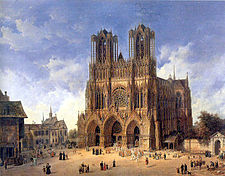- Nicolas de Grigny
-
Nicolas de Grigny (baptized September 8, 1672 – November 30, 1703) was a French organist and composer. He died young and left behind a single collection of organ music, which together with the work of François Couperin, represents the pinnacle of French Baroque organ tradition.
Contents
Life
 Notre-Dame de Reims, painted c.1800 by Domenico Quaglio the Younger. This is the church where de Grigny worked during the last years of his life.
Notre-Dame de Reims, painted c.1800 by Domenico Quaglio the Younger. This is the church where de Grigny worked during the last years of his life.
Nicolas de Grigny was born in 1672 in Reims in the parish of Saint-Pierre-Le-Vieil.[1] The exact date of his birth is unknown; he was baptized on 8 September. He was born into a family of musicians: his father, his grandfather, and his Uncle Robert were organists at the Reims Cathedral, the Basilica of St. Pierre and St. Hilaire, respectively.[2][3] Few details about his life are known, nothing at all about his formative years. Between 1693 and 1695 he served as organist of the abbey church of Saint Denis, in Paris (where his brother André de Grigny was sub-prior[2]). It was also during that period that de Grigny studied with Nicolas Lebègue, who was by then one of the most famous French keyboard composers.[4] In 1695 de Grigny married Marie-Magdeleine de France, daughter of a Parisian merchant.[1] Apparently he returned to his hometown soon afterwards: the record of the birth of his first son indicates that de Grigny was already in Reims in 1696. The couple went on to produce six more children.[2]
By late 1697 de Grigny was appointed titular organist of Notre-Dame de Reims (the exact date of the appointment is not known), the city's famous cathedral in which French kings were crowned. In 1699 the composer published his Premier livre d'orgue [contenant une messe et les hymnes des principalles festes de l'année] in Paris. De Grigny died prematurely in 1703, aged 31, shortly after accepting a job offer from Saint Symphorien, a parish church in Reims.[2] His Livre d'orgue was reissued in 1711 through the efforts of his widow.[1] The collection became known abroad: it was copied in 1713 by Johann Sebastian Bach, and later by Johann Gottfried Walther.[2]
Work
Nicolas de Grigny's only surviving music is a large volume of organ works, Premier livre d'orgue (Paris, 1699; second edition 1711). The second edition was the only one known until 1949, when the earlier print was discovered—a single surviving copy at Bibliothèque nationale de France.[1] The first modern edition, by Alexandre Guilmant, 1904, was based on the 1711 version.
Unlike many other French livres d'orgue of the time, de Grigny's publication contains no preface. The collection is in two parts: the first is a mass setting, the second comprises settings of five hymns for Lauds and Vespers: Veni Creator (5 versets), Pange lingua (3 versets), Verbum supernum (4 versets), Ave maris stella (4 versets) and A solis ortus (three versets). There are 42 pieces overall. The plan of the mass is as follows:
- 5 Kyrie versets,
- 9 Gloria versets,
- an offertory,
- 2 Sanctus versets,
- 1 Benedictus verset,
- an Elévation,
- 2 Agnus Dei versets,
- a Communion, and
- an Ita Missa Est verset.
Like most of his predecessors, de Grigny uses chant melodies from the Gregorian Mass IV, Cunctipotens Genitor Deus. However, he confines chant usage to first versets of each section: for example, the actual Kyrie chant only appears in the first Kyrie verset, Kyrie en taille à 5, etc. The hymns adopt a variety of structures, but invariably begin with a Plein Jeu verset followed by a fugue; the same can be said about every section of the mass. The collection also includes a Point d'orgue, a piece based on a long pedal point.
Media
See also
Notes
References
- Apel, Willi. 1972. The History of Keyboard Music to 1700. Translated by Hans Tischler. Indiana University Press, 1972. ISBN 0-253-21141-7. Originally published as Geschichte der Orgel- und Klaviermusik bis 1700 by Bärenreiter-Verlag, Kassel.
- Halbreich, Harry. Liner notes to: Nicolas de Grigny - Premier livre d'orgue, Michel Chapuis (organ). 1976/1987, Auvidis-Astrée E 7725.
- Higginbottom, Edward. "Nicolas Lebègue", Grove Music Online, ed. L. Macy (accessed 25 December 2006), grovemusic.com (subscription access).
- Howell, Almonte; Sabatier, François. "Nicolas de Grigny", Grove Music Online, ed. L. Macy (accessed 21 November 2006), grovemusic.com (subscription access).
- Silbiger, Alexander. 2004. Keyboard Music Before 1700 (in: Routledge Studies in Musical Genres). ISBN 0415968917, 978-0415968911
External links
Biography
- Biographie à Musicologie.org Biography and extended bibliography (French)
- Medieval.org: Grigny: Hymns Includes partial discography and miscellaneous details about the composer
Scores
- Free scores by Nicolas de Grigny in the Werner Icking Music Archive (WIMA)
- Free scores by Nicolas de Grigny at the International Music Score Library Project
- Free scores at the Mutopia Project
Audio
Categories:- 1672 births
- 1703 deaths
- Baroque composers
- French composers
- Composers for pipe organ
- French classical organists
Wikimedia Foundation. 2010.
